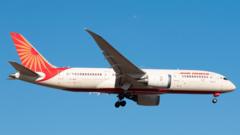The preliminary investigation into the tragic Air India Flight 171 crash, which resulted in 260 fatalities in June, reveals unsettling new details that deepen the enigma surrounding the incident. Just moments after takeoff, the Boeing 787 Dreamliner experienced a critical failure when both fuel control switches were inexplicably moved to the "cut-off" position, disrupting the engines' fuel supply and causing a complete power loss. This unsettling maneuver, usually reserved for post-landing, has raised significant questions.
Cockpit voice recordings have shed light on the events during the catastrophic moments. One pilot can be heard questioning the other, asking why the switches were set to "cut-off." The reply, unsettlingly vague, was that the other pilot did not perform that action. At the crash moment, one engine was in the process of regaining thrust while the other had reignited but was not yet delivering full power.
The flight only ascended to 625 feet in clear weather conditions before disappearing from radar less than a minute after takeoff, leading to one of India's most perplexing aviation mysteries. Investigators are currently scrutinizing the aircraft wreckage and the cockpit voice recorder for answers. Initial reports suggest that the lever-lock system on the fuel switches—designed to avert accidental activation—was functioning correctly.
Experts in aviation safety are expressing astonishment over the circumstances of this crash. A former airline accident investigator indicated that while accidental activation of switches is always a possibility in emergencies, the lack of reported anomalies prior to the incident makes such an explanation far less plausible in this case. Querying whether either pilot intentionally or mistakenly moved the switches only raises more troubling questions.
Further complicating the investigation is the need to ascertain which pilot was responsible for manipulating the fuel control switches. Without a clear identification of voices from the cockpit recordings, the ambiguity surrounding the actions leading to the crash will persist. Voices of pilots familiar with the incident are crucial for corroborating what transpired. The necessity of implementing cockpit video recording systems, as proposed by safety authorities, is increasingly apparent, as visual evidence would clarify critical moments leading up to the crash.
Curiously, the report also highlights concerns raised by the US Federal Aviation Administration in December 2018 regarding the locking feature of fuel control switches on various Boeing models, including the 787. This advisory did not trigger an Airworthiness Directive, resulting in Air India not performing subsequent inspections. Experts are debating whether this malfunction could have contributed to the incident.
Investigators have also ruled out fuel contamination as a cause, and mechanical failure has not yet been established. Noteworthy is that the aircraft's Ram Air Turbine (RAT) deployed during the flight, a clear signal that both engines had succumbed to failure, underlining the gravity of the situation.
The crew's attempts to recover the aircraft are being scrutinized. Describing a situation where immediate responses to dual engine failure are critical, experts speculate that the lack of altitude left the pilots with insufficient time to regain control effectively. Overall, the combination of unsettling cockpit conversations, safety feature ambiguities, and procedural concerns continues to puzzle investigators as they work meticulously to uncover the truth behind this tragic aviation disaster.



















